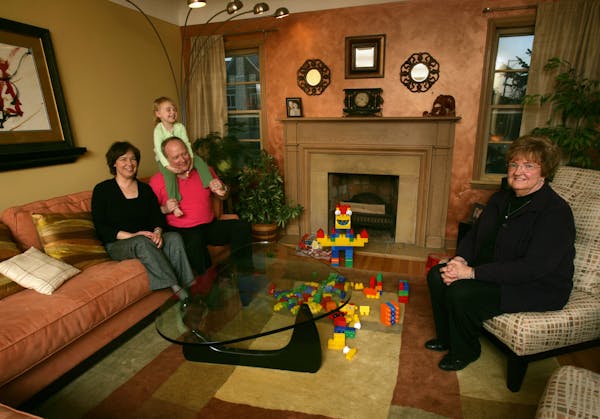Builder David Reed's mission was to construct a home for two families -- a young couple, their child, and the husband's retired parents.
So he built two homes in one. The rambler in Chisago City, Minn., has an owners' suite, full kitchen and living and dining room, plus a similar configuration on the walkout lower level where the parents live. It's a living arrangement that allows the families to share expenses and support each other.
"As boomers age and the cost of housing and land goes up, we will see more families bringing their retired parents into their home," said Reed, owner of David Scott Homes in Mendota Heights.
Those multigenerational dwellers, including siblings who choose to live together and adults who are moving in with their senior parents, are changing the way builders, architects, remodelers and even rental property management companies do business.
"There's more discussion than ever about designing for different living situations," Reed said.
How do today's home plans differ from the duplexes and triplexes that were popular during other periods of economic contraction?
The housing built for today's multigenerational dwellers often has two master bedroom suites and common living spaces that share a large kitchen with lots of storage, "getaway" rooms and private entrances. Traditional duplexes usually had two exact floor plans stacked atop or next to each other.
While some of these communal living spaces have mirror-image layouts atop one another, others have flexible floor plans that can evolve as family needs change. That includes features aimed at aging-in-place parents who will eventually need wider hallways and no-step entryways for wheelchairs and walkers.
"Thoughtful good design can create total autonomy and privacy for families of different generations living together," said Shelly Rae Linnell, an independent contractor who designs layouts for builders and their clients.
Doing so can be challenging and costly, said architect George Cundy of Cundy, Santine and Associates in Shoreview, because of the complexity of trying to fit more than one family under the same roof.
"Grandma may need a separate sitting area and a place to entertain her friends," said Cundy who is also chairman of the Builders Association of the Twin Cities' 50-Plus Housing Council, which looks at housing issues for older residents.
Such living arrangements can mean that each family will want a private entrance. For example, Reed built a two-level garage for the Chisago City rambler that enables occupants of each level to enter their unit from the same level as their garage.
Minimizing noise is another design consideration that costs more, but is important to maintain privacy for each family. The Chisago City house has spray foam insulation between floors and ductwork that's installed to eliminate noise transmission between levels.
Architects are increasingly being asked to come up with clever ways of accommodating the growing trend. Michael Roehr recently transformed a four-square home built for one family in St. Paul into a house that meets the needs of the homeowner, her children and her mother by building an addition and reconfiguring the main floor.
This modern version of what in the past was referred to as "a mother-in-law apartment" includes a private main-floor suite for the older parent that is inconspicuous to visitors.
"I'm seeing a shift to this type of living," said Roehr, principal, Roehr Schmitt Architecture in Minneapolis. "And with the retirement of baby boomers, I anticipate doing more similar projects."
Many apartment and condo developers are also offering flexible floor plans that accommodate different living arrangements.
Arbor Pointe apartments in St. Paul were not specifically designed for multigenerational living, but senior-age children are living with their elderly parents in units that have two private bedroom suites -- one on each side of a large kitchen and living area. Twelve of the 47 units in the senior housing complex are configured that way, said Mary Anderson, property manager.
Some of the larger penthouse condominiums in Phoenix on the River in Minneapolis could be suitable for a 25-year-old moving back with Mom and Dad, or children caring for elderly parents. These three- and four-bedroom condos have a spacious kitchen, larger bedrooms, getaway room, and some universal design features to enable residents to use wheelchairs.
"The housing industry will have to be responsive to accommodate buyers and renters who want this way of living," said David Frank, director of development for the developer Shafer Richardson.
Although the demographics support more multigenerational housing, not all developers will embrace the concept. Specialized floor plans could be too restrictive for some renters and buyers.
"The demographics are always changing," said Noah Bly, who designs rental apartments for Urbanworks Architecture in Minneapolis. "We have to design for the long term and be as useful as possible for the broad market."
Lynn Underwood • 612-673-7619
